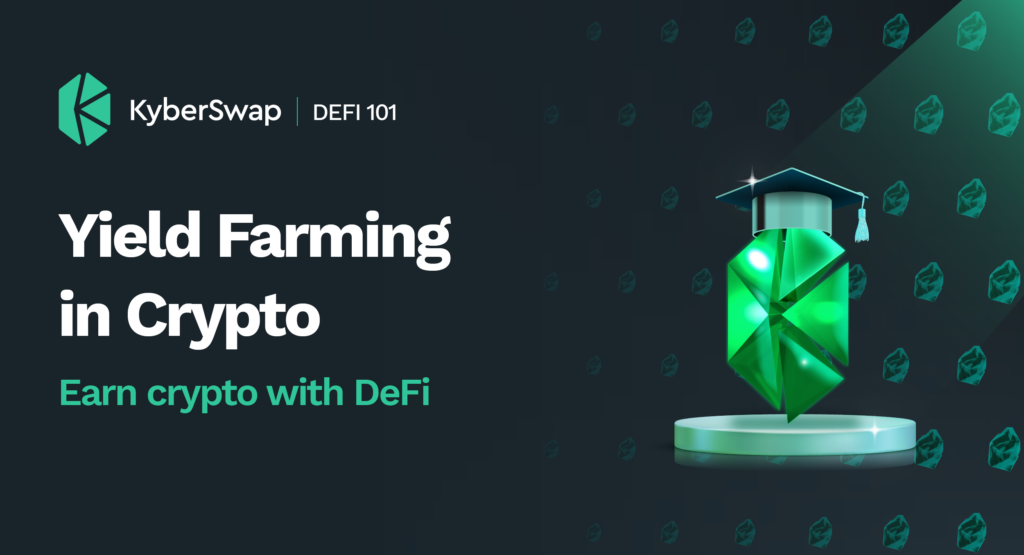Yield farming in crypto — also known as liquidity mining — is a useful way to maximize your assets by using what decentralized protocols have to offer.

Strictly related to the activity of providing liquidity to liquidity pools, DeFi crypto yield farming allows you to receive higher returns also on the earnings you receive as a liquidity provider.
In the DeFi space, there are many ways to earn passive income: yield farming is one of these, and since it’s a concept that often gets confused with different types of investments, it’s worth giving some definitions and making some differences with other DeFi services — especially staking and liquidity pools. We’ll also cover these differences in this article, but the focus is on yield farming — how it works, how it can help you to maximize your crypto assets and possible risks involved.
Crypto Yield Farming Explained — How Does It Work?
Yield farming is an innovative concept in the crypto space, but in reality it’s just similar to savings accounts and lending in the traditional financial system.
Essentially, yield farming is the practice of lending and staking your crypto assets to earn higher returns. ‘Farms’ are named after the fact that they allow your earnings to grow, and that’s exactly what happens. Of course, you need to consider that the amount of tokens earned increases, but this doesn’t necessarily imply that you’re going to increase the value of your interest — as we will cover later in detail.
Similar to how you earn interest in a bank, yield farming allows you to generate interest in the form of cryptocurrencies: this happens because the funds you put in DeFi farms will be at the disposal of other users, and they’ll be able to perform any action that will allow them to increase their capitals and return your funds with interest. That interest is what you’re going to earn.
It’s not a new concept, but the way you earn interest is different since it’s based on decentralized finance principles.
First, you won’t need to provide your personal details or credit score history to be able to participate in the market: all you need is your DeFi wallet.
Second, there is no central management of the funds: everything is automated thanks to smart contracts.
So, anyone who has the internet, a wallet and some funds to provide liquidity can profit from yield farming, no matter their financial history — since they won’t deal with banks or any other centralized financial platform.
But let’s see how it works. As we said, yield farming is strictly related to the activity of liquidity providers (LPs). LPs contribute to the correct functioning of decentralized exchange by providing liquidity, and there’s an incentive for them to do so: every time they add liquidity to a pool, they’ll receive part of the fees for the trades that occur in that pool. The amount of fees earned will be based on the amount of liquidity provided. Their LP tokens will represent their liquidity position.
But those tokens, if not used to further maximize profits, would just sit in the wallet of the LP. On the other hand, yield farming allows liquidity providers to get higher interest on their already existing strings of crypto passive earnings. All LPs need to do is put their tokens in a farm. As we mentioned at the beginning of this article, farming is not the only way to earn passive income in cryptos, so it’s useful to consider other kinds of investments — especially staking and liquidity pools — and the differences among them.
Staking is a way to support a particular crypto project: staking your assets is like having some shares of a company. In the crypto space, when you stake your assets, you receive rewards because you’re supporting the project, you’re contributing to its decentralization — making it more secure, and you’re reducing supply — allowing the asset to gain value.
When you provide liquidity, you’re contributing to the right functioning of DeFi exchanges: liquidity pools were mainly realized to be an alternative to order books — that is, the books that match buy and sell orders on centralized platforms — since there is no central database to manage orders. Each pool represents a different market, so you’re basically making markets more liquid, favoring stability and reducing risks related to volatility.
Yield farming has a strong correlation with liquidity pools, but in this case your goal is different: you’re always locking your assets in pools and smart contracts, but you do that to earn higher profits — as you do when you lend your assets.
This allows you and other traders, investors and speculators to profit from a wide range of strategies that permit you to put your crypto assets at work: other traders could use your funds to increase their capital and use it for larger trades, they could use them to find arbitrage opportunities and benefit from innovative tools like flash loans, you can move your assets each time you find a farm with a higher APY. There are no limits to the use cases and strategies you can realize, and anything can be done in complete anonymity. When it comes to decentralized finance, knowledge and inclusivity are two fundamental words, since anyone is able to use and benefit from financial assets available.
Yield farming can be a useful way of maximizing your crypto assets, but just like anything else, it is not without risks.
Annual Percentage Yield
We mentioned APY, but what does it mean? Many DEX farms calculate the interest on your invested assets in terms of annual percentage yield (APY). Differently from the APR (Annual Percentage Rate) that only considers the percentage of your return on a yearly basis, APY takes into account compounding — this means that interest is calculated not only on the principal, that is, the amount of tokens you initially invested — but also on the interest you earn over time, further increasing your returns.
Possible Risks
Risks in crypto yield farming can take different forms and can be related not only to the volatility of the market, but also to the very infrastructure of the DeFi space.
To mention some of the most common risks in yield farming:
- Volatility: volatility is the cause of other risks like impermanent loss. If you invest in and stake an asset whose price experiences large changes in short periods of time, you might experience considerable losses. It’s also the reason why crypto assets give such high returns, so it’s up to traders and investors to attentively consider an investment according to their needs and the level of risk they can afford. Some crypto projects have a vesting period — that is, a period of time in which the tokens distributed during the launch of a new project can’t be sold — and this can allow investors to avoid volatility.
- Frauds and rug pulls: unfortunately, the crypto space is also where many fraudulent projects find a place. This can also happen in more traditional markets, but since the DeFi space doesn’t put in place all the international regulations related to Anti Money Laundering and Know Your Customer procedures, it’s harder to spot fraudulent schemes and to punish those who create them. Rug pulls are still a reality: just to mention one of the most popular cases, also a popular project like SushiSwap was affected by a rug pull, when Chef Nomi — the founder of the project — took the funds of the investors. Fortunately, SushiSwap had a good end, but it’s not always the case in the crypto space, and traders and investors should always try to evaluate the reliability of a project first.
- Risks related to smart contracts: the whole DeFi space relies on smart contracts to work, but even if they can be considered safe, there might be risks like bugs and other kinds of errors in codes. Fortunately, solutions like third party audits are implemented by many platforms.
- Regulatory risks: regulators don’t always appreciate the functioning of the crypto industry — especially when it comes to decentralized finance. Very simply put, the point is why financial products that are so similar to traditional instruments, like yield farming, shouldn’t follow the same regulation of the traditional financial market? How to prevent and deal with frauds if DeFi platforms are not even able to recognize their users? These are good questions, and maybe in the future DeFi will need a viable compromise between traditional regulations — that actually cut out from the financial system a very large part of the global population — and full decentralization — where, unfortunately, financial instruments can be found and then used also by people who have illegal intentions.
Why Farm?
Just to give you real and reliable information, the yield farming rankings provided by CoinMarketCap can prove that it’s very easy to find farms that give you APYs higher than 1,000,000,000% — the scope of this article is not to give you financial advice, so always do your own research (DYOR), also because these farms usually come with high risks, volatility and impermanent loss.
To make a comparison with the traditional market, returns barely exceed 10% when you adjust them for inflation.
So, the most immediate and intuitive benefit of crypto yield farming can be found in profitability. Even if this kind of profitability is a direct consequence or risks, farming could be a good option for those who look for higher returns.
Moreover, farming opportunities can be exploited by anyone — even by those who don’t have access to a bank account or who don’t have a good credit score history.
Final thoughts
Crypto yield farming is the source of both misunderstandings and profitable opportunities.
Misunderstandings because it might be hard to navigate all the services offered by decentralized finance — and it’s complicated to spot the differences between yield farming and other opportunities, since staking, liquidity pools and farming are strictly connected.
Yield farming offers profitable opportunities because it allows you to create more streams of crypto passive income.
With crypto yield farming you definitely put your money at work: the strong correlation between liquidity pools and farms allows you to earn higher returns on the passive income you earn thanks to pools. Moreover, as we covered in this article, your interest is calculated by using APY, which takes into account compounding for a full optimization of your capital.
Of course, this doesn’t come without risks: volatility and all its consequences can negatively affect your investments, and there are also risks that involve smart contracts, or frauds, or possible regulatory risks.
Nevertheless, all those who put their efforts and invest in a better understanding of the DeFi space, will be able to further reduce risks and to benefit from the decentralization of this blockchain-based financial system: they’ll be able to better spot frauds, to make a good analysis of each project before investing, to take appropriate precautions to reduce losses.
Follow our Kyber Academy to get all the DeFi info you need!



